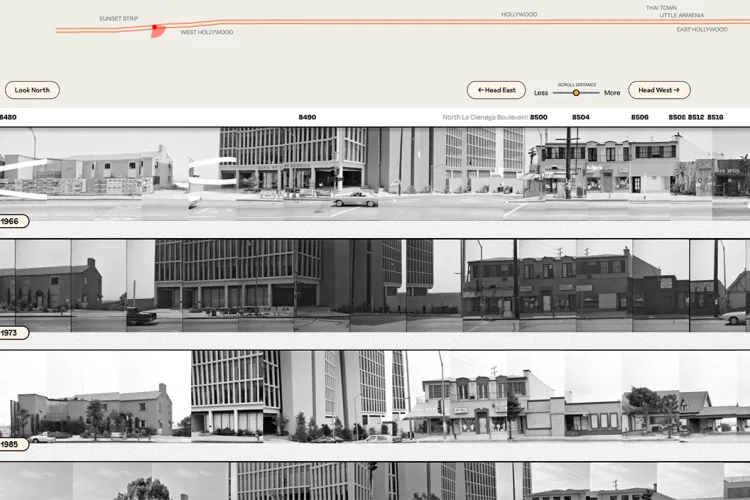Brian Goldstein’s Sunset Over Sunset Explores Urbanization in Los Angeles

By bringing five decades of photographs together in an easy-to-navigate and fun tool, Sunset Over Sunset raises questions about what changed in 20th-century cities.
Associate Professor of Art History Brian Goldstein recently launched Sunset Over Sunset, an urban historian’s version of Google Street View. The project is an immersive website that takes visitors on a block-by-block tour of Sunset Boulevard, one of the country’s most iconic thoroughfares, pairing photographs with data that allows visitors to go “behind” the street’s facades.
Goldstein co-directed the effort with Francesca Russello Ammon, associate professor of city and regional planning and historic preservation at the University of Pennsylvania Stuart Weitzman School of Design, and Garrett Dash Nelson, president and head curator at the Leventhal Map & Education Center at the Boston Public Library.
The website they developed with the help of Rob Nelson, director of the Digital Scholarship Lab at the University of Richmond, and several research assistants, including Elena Moore ’21, Dorothy-Rui Corrigan ’23, Min Fruman ’24, and Hope Dworkin ’26, builds on the Getty Research Institute’s newly digitized archive of American artist Ed Ruscha's landmark series of Los Angeles photographs. By bringing five decades of those photographs together in an easy-to-navigate and fun tool, Sunset Over Sunset raises questions about what changed in 20th-century cities — and why — that have implications for community and economic development, historic preservation, and urban design today.
“Our primary ambition is to make an amazing archival resource available to historians, urbanists, and anyone else who can use Sunset Over Sunset to interpret and understand urban change through the repeated photography of one iconic street,” says Goldstein.
Ruscha is known for his paintings, prints, and books, including Every Building on the Sunset Strip, his 1966 work recording one stretch of Sunset Boulevard. Goldstein explains, “He returned to the street many times between the 1960s and the 2000s, photographing its entirety from a vehicle. We have incorporated one of those panoramas from each decade, and added ‘depth’ to the depicted facades by including different kinds of information at each address — U.S. Census records, business directories, and newspaper coverage, among others, as well as a growing number of thematic stories that show how visitors might use this resource in their own research.”
In focusing on Los Angeles, Sunset Over Sunset provides a new tool for tracing local, national, and global histories of migration, economic transformation, architectural innovation, and cultural change in the late 20th century. The images of facades and the data behind them reveal how small-scale changes contributed significantly to the evolution of cities, challenging the common focus on large-scale development. The exhibit also highlights the impact of individual and community actions in shaping the city.
The project was made possible by a Digital Humanities Advancement Grant from the National Endowment for the Humanities, support from the Getty Research Institute, which houses Ed Ruscha’s Streets of Los Angeles Archive, and institutional support from Swarthmore College, the Stuart Weitzman School of Design, and the Leventhal Map & Education Center at the Boston Public Library.
The website’s essays include works by historians Mark Padoongpatt, Alexander Tarr, and AnneMarie Kooistra, as well as forthcoming pieces by Goldstein, Ammon, Michael Amezcua, Annie Berke, Max Böhner, Margaret Crawford, and Elizabeth Goodspeed. The essays illuminate stories of Sunset and the modern city, including Thai and Latinx immigration, banking and globalization, transportation and climate change, place-making, and the advent of now-familiar urban types, like the mini-mall.
“One of the revelations of this project has been the amazing number of stories one can find by looking at images of a city closely,” says Goldstein. “The events registered in Ruscha's photos range from the trivial (an early sign advertising the Red Hot Chili Peppers outside EMI's recording studio in 1985 [6930 Sunset]) to the monumental (the growing presence of immigrants from Central America and Southeast Asia registered in the storefronts and restaurants where they sought to establish themselves in a new country).
“These remind us that as much as cities change in big ways over time,” he adds, “much of the action shaping those changes happens at the level of individual people, working year by year and property by property.”



